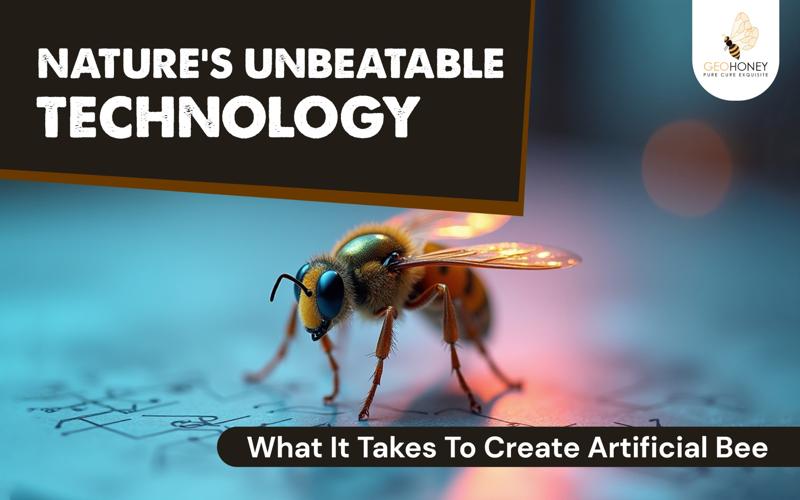- Tokyo: 22:28
- Singapore: 21:28
- Dubai: 17:28
- London: 13:28
- New York: 08:28
Nature's Unbeatable Technology: What It Takes to Create Artificial Bee

In this era of scientific breakthroughs and engineering excellence, there are very few things that experts are still not able to achieve and chances are they will not be able to do so in the near future as well. And at the top of the list is the creation of artificial honey bees.
These tiny pollinators are a true marvel of natural engineering. The unparalleled aerodynamic prowess, exceptional navigational skills, social intelligence, and countless other hidden superpowers of honey bees are near impossible to replicate with the current technology at our disposal.
The founder of Geohoney and the CEO of B A Barry Group, Mr Basem Barry, says,
“Bees are nature’s engineers, architects, and communication specialists, and humans still have a long way to go to create an artificial creature with all these capabilities.”
This blog throws light on what it takes to create artificial honey bees and why it is not an easy task to beat this unbeatable technology of nature, so keep on reading till the end.
Honey Bee: Nature’s Unbeatable Technology and a Super Machine
Masters of Flight
Architectural Genius
Excellence In Navigation
Sensory Integration
Pollination Mechanics
Social Intelligence
Creating Artificial Honey Bees: What Will It Take?
Replicating Complex Biology
Energy and Battery Life Issues
Manufacturing At Scale
Replicating Ecological Intelligence and Hive Mind
Honey Bee: Nature’s Unbeatable Technology and a Super Machine
The following are a few points that show what makes honey bees nature’s unbeatable technology and why creating a similar artificial creature is beyond our reach at the moment.
Masters of Flight
There is a long list of interesting facts about honey bees, but probably the most fascinating is their exceptional flying abilities. Bees can flap their wings more than 200-230 times in a second and fly up to 15km in one trip. And not just that, even at that speed, they can hover, dart, and land with remarkable accuracy.
The movement of a bee’s wings is asymmetrical, and they can adjust it instantly according to wind speed, wind direction, and turbulence from other external factors.
To replicate this movement, engineers have to develop miniature motors and actuators that can mimic this behavior without overheating or draining power in mere seconds, which is a big challenge.
Architectural Genius
Bees create perfect hexagons in their honeycomb, which is a marvel of natural engineering. Bees have a deeper understanding of the fact that a hexagon is the only shape that they can use to cover a surface with equal-sized units without wasting space or wax.
Bees instinctively calculate and then build hexagons, which is something that humans and artificial robots can do after years of training and using CAD software.
Building an autonomous honey bee that is this precise in its behavior without external assistance is far from possible.
Excellence In Navigation
Bees are sensitive to polarized light, magnetic fields, and even scent trails. They can detect and use this data to travel for miles without losing their way. The excellent memory of these creatures, along with their ability to accurately communicate the direction and location of nectar sources for creating raw honey using special dances and bodily movements, makes them true natural geniuses.
Creating miniature artificial honey bees that possess this level of environmental awareness while also weighing very little is another major roadblock.
Sensory Integration
Apart from creating organic honey, bees can also detect and process visual, chemical, humidity, and smell signals almost instantly. They possess two compound eyes that can detect ultraviolet patterns. In fact, this is exactly what bees use to identify nectar sources.
To mimic the sensory capabilities of bees, researchers have to create creatures with multi-modal sensors and fast processing speeds while also keeping the small size and lightweight construct of the bee in mind.
Pollination Mechanics
The bees’ role in humanity’s future is more crucial than we give them credit for. These creatures pollinate more than 70% of the food crops of the world. Countless fruits, dry fruits, and vegetables will perish without bees. But how exactly do bees pollinate?
Bees possess fuzzy bodies, and they generate electrical charges to attract the pollen and keep it stuck to their bodies. This pollen is transferred from one flower to another, which triggers their reproduction.
It is a big challenge to create artificial bees that carry out this passive pollen collection process without damaging the flowers or plants that they come in contact with.
Social Intelligence
Bees possess social intelligence, which is why a hive with thousands of bees operates harmoniously and with full coordination. Bees maintain the hive’s temperature and divide labor.
They forage, raise the young, and attend to the queen instinctively and without a central command. Bees function just like a distributed network, but with perfect uptime.
Creating an artificial bee that is able to coordinate and behave like these social creatures is another big challenge that needs to be addressed.
Creating Artificial Honey Bees: What Will It Take?
It is clear from the previous discussion that bees are undoubtedly nature’s unbeatable technology when it comes to their social, architectural, and navigational capabilities. We still have a long way to go to create artificial bees that can mimic even a fraction of the behaviors of their natural counterparts.
Here is what it will take to create artificial honey bees.
Replicating Complex Biology
The biggest challenge that we need to overcome is to design artificial bees that can mimic the complex honey bee biology. There is millions of years of evolutionary fine-tuning behind honey bees that is both intricate and unbeatable.
Here are a few points to give you a general idea.
A honey bee possesses more than 1 million neurons in its brain that help with its learning, communication, and navigation.
They possess fuzzy feet and bodies to trap and transfer pollen.
Honey bees possess five eyes. Two for vision and color detection, and three smaller ones for light detection.
They have six legs for clawing and gripping.
They have two antennae for sensing smells and vibrations.
Replicating this complex biological creature is far beyond our current engineering capacities. Unlike machines, bees can grow, adapt, and heal, which is another feature that is near impossible to mimic.
Energy and Battery Life Issues
Bees feed on nectar, which gives them the power to fly for hours. Artificial bees will need ultra-efficient and miniature energy systems if they are to give a similar performance, which is a big issue.
Most modern micro-drone technologies have a very short life of about 10 minutes. Artificial bees will thus need frequent recharging. And not just that, meeting the energy needs of tens of thousands of bees in itself is a major issue.
Manufacturing At Scale
A functioning bee colony has thousands of members. If you want to mimic this, you will need to create countless insect-sized robots with precise anatomy and programming.
Keeping each of these creatures powered, maintained, and updated is not easy. Moreover, artificial honey bee deployment in diverse and unpredictable environments is another major hurdle.
Manufacturing artificial bees at a large scale entails astronomical costs and many variables that make it very hard to do so.
Replicating Ecological Intelligence and Hive Mind
Every honey bee is a part of a superorganism that acts and behaves like a collective brain. There is collective decision-making without centralized intelligence.
Bees divide roles, decide when to forage and when to swarm, and they use coordinated fanning to regulate the hive's temperature. No artificial system has been able to perform these diverse high-precision roles at once.
Creating artificial bees is not about producing robots, it is about recreating an entire ecosystem which far beyond our capacities at the moment.
Conclusion
Honey bee is a masterclass in biological design that combines ecological harmony, social intelligence, controlled flight, and seamless navigation. Understanding all of these aspects is one thing, but trying to replicate them is a whole other matter.
Modern technology is not yet at a stage to fully decode and then replicate these natural geniuses. Bees are a humbling reminder that there are some natural phenomena that we still cannot conquer, even with our latest tools and technologies.
Creating an artificial bee is a big engineering challenge and a promising research avenue that will continue to fascinate, motivate, and inspire scientists for many years to come.
Visit our website Geohoney, today to learn more about bees and to explore our wide range of monofloral honey varieties to get the best flavor and surprising health benefits.


